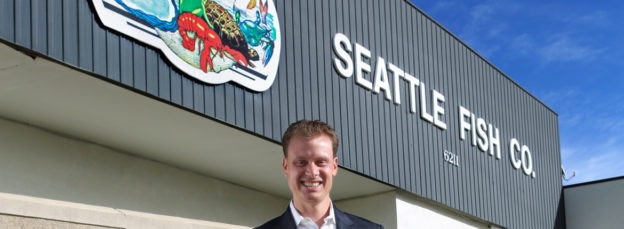James Iacino, much like his employees who work on the dock, or on the production floor of his 65,000-square-foot Denver-based seafood facility, knows that there’s no rest for the weary. Ambitious, insatiably curious, tireless and always striving to improve, the 31-year-old president and CEO of Seattle Fish Co., a multigenerational company that operates around the clock – and supplies more than 6.5 million pounds of fish and seafood to nearly 700 customers throughout the Rocky Mountain Region – kicks into gear while most of us are still slumbering. James, who earned his fishing stripes by working at a restaurant in Japan and spending countless hours voyaging across the United States and Canada to visit fish purveyors, began his career at Seattle Fish when he was a teenager, and throughout his impressive tenure, has elevated Seattle Fish Co. to one of the most highly regarded family-owned companies in Colorado. Here, in James’s own words, is his success story.
SEATTLE FISH GOT ITS NAME because of my grandfather Mose, who came over from Italy, got a second-grade education in Denver and started working at a young age at the family meat market in what’s now LoDo. There was a passenger train from Seattle that would pull into Union Station, and my grandfather would meet the train, which had its own chef who happened to sell oysters, and my grandfather would buy oysters from him, and then he’d sell the oysters from a cart that he pushed through downtown. He continued to buy oysters and seafood from that same chef, and then, from a little stall in the market, he starting selling all the seafood he’d bought. Then, in 1918, when he was just sixteen, he went out and started Seattle Fish Company in LoDo. The seafood he bought was all from Seattle, and that’s how the name came about. Seattle Fish was in that same location until 1982.
I WAS BORN INTO THIS BUSINESS, and starting working at Seattle Fish when I was around eleven or twelve, coming in at 4:30 in the morning with my dad and sorting paperwork. The yellow papers would go here; the white papers would go over there.
DURING MY SCHOOL BREAKS – Christmas break and spring break – I worked the night docks, loaded trucks and did lots of data entry, mostly thousands upon thousands of credit memos. I’d cut fish, too, and did that until I was about sixteen.
IN THE EARLY DAYS, before I started in the fish business, I wanted to be a pilot – my dad was a private pilot – and then in college, I was interested in politics. I still am. I did a double degree in political science and business management at CSU, and I studied Japanese, too. And I still bleed CSU.
I WENT THROUGH A PERIOD OF DISTRACTIONS, and I was screwing around a lot and really trying to figure out what I wanted to do, and I remember during my sophomore year at CSU asking my dad if he wanted me to take over the company, and his response was this: “You haven’t shown me a reason why you should take over the company.” It was a wakeup call for me, and he was right, so I started going to class and getting it together.
WHEN I WAS IN COLLEGE, I was still working at Seattle Fish, doing retail sales, taking orders and driving trucks, and then my dad told me that I needed to learn more about fish, so I went to Japan to learn from the best.
I SPENT JUST UNDER TWO MONTHS IN JAPAN working at a little Japanese restaurant in Fukuoka, which is owned by Toshi Kazaki, who also owns Sushi Den with Yasu, his brother. I went to the markets with the staff, picked up fish, and I learned how to cut rolls. It was brutal, and I was pretty much slave labor in the kitchen – the big white guy surrounded by Japanese military kids. We all brought dictionaries with us so we could communicate; I taught them about a Jägerbomb, and they taught me about hard work.
THE JAPANESE have tremendous respect for fish – and the art of cutting fish; it takes years to apprentice and eventually be rewarded with the privilege of cutting fish.
online pharmacy buy desyrel online best drugstore for you
The Japanese put a ton of value on their seafood – it’s a huge part of their culture, and you really do have to work your way up before you’re rewarded.
THERE WAS STILL SO MUCH MORE TO LEARN, so I came back to Denver and immediately started traveling all across the United States and Canada to visit a ton of Seattle Fish seafood vendors so that I could learn from the experts. I traveled to Alaska to understand as much as I could about halibut, and to the Gulf of Mexico to familiarize myself with tuna. For six months, I just really focused on going around the States and meeting all the vendors so I could learn about everyone’s unique knowledge about individual products. They were the experts, and I just wanted them to teach me everything they knew. They knew a helluva lot more than I did; some of those seafood companies have been doing what they do for 100 years.
I CAME BACK TO DENVER, and to Seattle Fish, where I got my first salaried job in the purchasing department. I was all of 22 years old and coming in at 5:30 in the morning. I didn’t really have a particular path that I wanted to follow at the time – it just sort of evolved, and after working in the purchasing department for about a year, I became a sales rep and then a sales manager.
IT WAS ALWAYS MY DAD’S GOAL to put a team in place at Seattle Fish that would allow him to step back and retire. In 2010, I took over his role as president, and in 2013, I became the CEO of Seattle Fish. But I knew there were ways to improve and continue to make this company even better – and it’s always been a team effort. I knew, too, that I wanted to keep learning, so I went back to school.
I GOT MY MBA FROM CSU because I really wanted to master the knowledge of running a business. It gave me confidence, and it silenced the people who said I was just a kid. I wanted to be qualified – very qualified – to run Seattle Fish, and I’m also big on continuing to improve, both personally and professionally, and getting my MBA did that for me.
WE HAVE A HUGE HISTORY IN DENVER, and we’ve been part of this great community for 96 years, a longevity that’s awarded us the opportunity to develop so many amazing long-term relationships along the way. We’ve sold fish to the Oxford Hotel and the Brown Palace Hotel since the turn of the century; we were here during the Great Depression and donated seafood to St. Anthony’s; and we’ve continued to grow – and evolve — with the community. We are Denver, and we’ve been around longer than anyone else in food service.
WE INVEST IN OUR PEOPLE, and we take very good care of our employees. We’ve been here a long time, and so have our people, some of whom have been here for twenty years and longer. We hire employees and they stay – they make us their lives – and we try to build opportunities for the people who want careers. Innovation, quality and service are our core values, but we have a lot of fun here, too. If you like food in general, this is a great place to work, and it’s our great team of employees who help us create and innovate and continue to meet – and exceed — our core values.
WE’RE CUTTING EDGE WHEN IT COMES TO SEAFOOD, and we reinvest our profits so that we’re always at the top of the innovation ladder. We’re also leaders in sustainability efforts, and while this is an old industry, we’re at the forefront of it.
OUR WEALTH OF KNOWLEDGE IS UNPARALLELED, and our seafood reps know fish better than anyone. We want to be the go-to source — the seafood experts for customers, press and consumers alike — and if someone has a question about seafood, our goal is to have the answer, and to have the answer as quickly as possible.
IF IT SWIMS, WE HAVE IT, which means that we source the best products from around the world, and those products get here in the most pristine condition possible – and as quickly as possible. And we hand-cut all of our fish to whatever specifications the chef or grocer needs. We also have one of the largest refrigerated networks in the city.
OUR RELATIONSHIPS WITH FISHERMEN are unequaled. We’ve had super-strong relationships with fishermen and processors for decades.
online pharmacy buy flagyl online best drugstore for you
We meet with them regularly, tour their facilities, test their products and promote their products. And, in return, they support our efforts to supply our customers with the best fish and seafood.
WE’RE HIGHLY COMMITTED TO SEAFOOD SUSTAINABILITY, and to that end, we have our own Green Team, plus we’re the only seafood wholesaler in Colorado with certification from the Marine Stewardship Council, an eco-labeling organization that ensures that seafood is traced back to a sustainable fishery. We’re also incredibly proud of our new solar array, which will reduce our annual carbon emissions by an estimated 285,000 pounds.
THE PERCEPTION THAT DENVER CAN’T GET GREAT SEAFOOD is a complete myth. On the contrary, Denver is uniquely positioned in the middle of the country, which means we get fish from the East and West Coasts oftentimes more quickly than you can get it on the coast. If you’re eating American red snapper in Portland, for example, that fish flew over Denver to get to you Portlanders. If you’re eating lobster in San Francisco, that lobster flew from Maine and over Denver before it got to San Francisco. All wild salmon comes from Alaska, so if you live in Florida, the wild salmon flew over Denver first. There’s this misconception that if you live on the water, all the fish came out of that water, and that’s not true. In reality, fish comes from all over the globe, and the fish you’re eating is most likely from somewhere else other than where you live. Denver is the shortest distance from Los Angeles, Seattle, Boston and Miami – four major seafood ports – and Seattle Fish gets the widest variety of fish and seafood for the shortest distance. That’s a fact.

